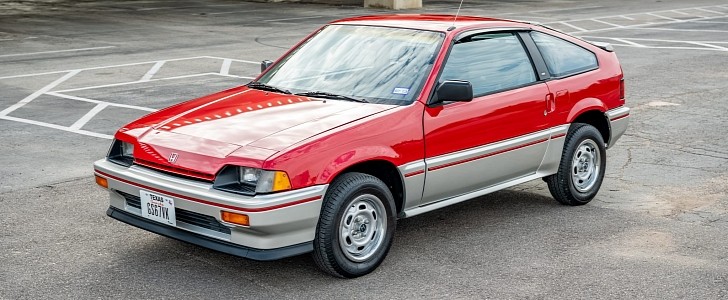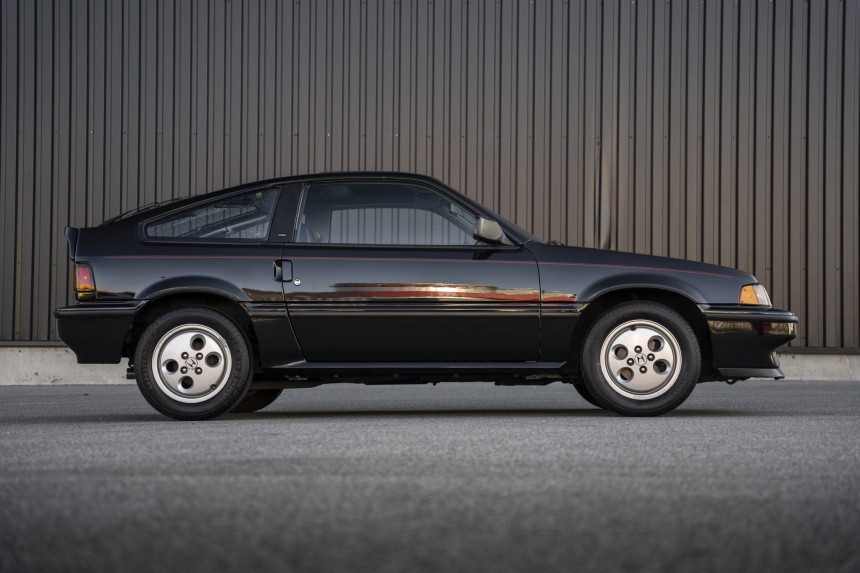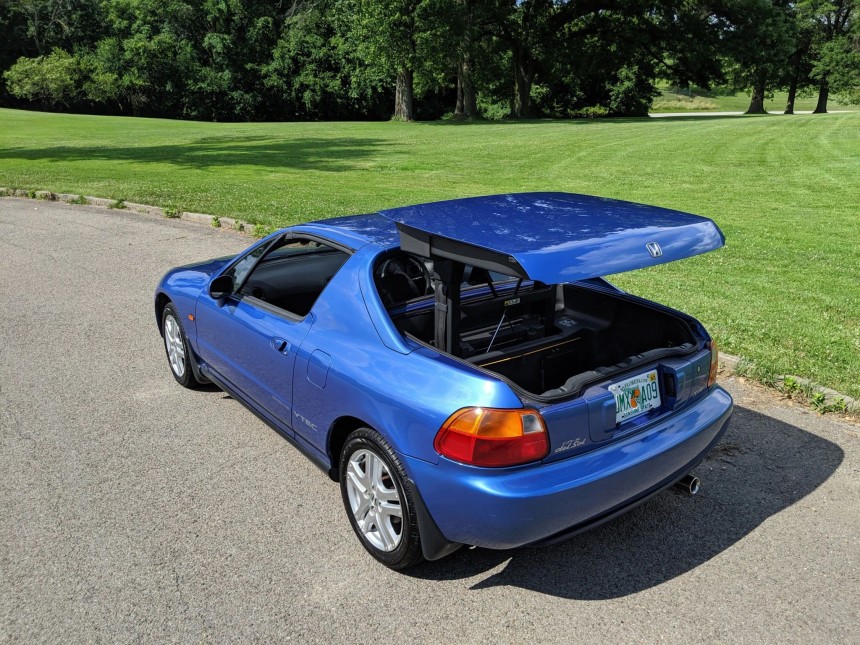Initially specialized in motorcycles, Honda found commercial success in the automotive sector with the first-gen Civic that was introduced one year before the 1973 oil crisis. By the early 1980s, the Japanese automaker found itself in a bit of a pinch given its boring image.
Honda’s fortunes turned for the better in 1983 with the reveal of the CRX. The most widely accepted meaning of this acronym is Civic Renaissance Experimental, which does make sense given the Civic-sourced drivetrain. Rolled out three months after the Civic’s third generation went official, the Kammback-tailed sport compact was created specifically for the Japanese market, where it was marketed under the Ballade Sports CR-X moniker.
Increasing pressure from distributors convinced the Japanese company to ship this model to a few other markets, including the United States, where the CRX fared pretty well over its long tenure. Defined by the K-tail aesthetic named after German aerodynamicist Wunibald Kamm, the boxy three-door coupe features a small-ish frontal area in addition to a low-ish roofline. More aerodynamic than the Civic of that era, the CRX is dressed in steel and plastic, as you’d expect of a little hatchback from the 1980s.
The first-generation CRX also boasts a rather spacious trunk, a gloss-black panel flanked by the taillights, recessed headlights with retractable flaps, and a triangular instrument binnacle. A three-spoke steering wheel frames two large analog gauges for the engine and vehicle speed, plus two smaller readouts for the water temperature and fuel. The tachometer and speedometer flank a rectangular bank of warning lights. The ventilation system’s controls are neatly integrated on a black plastic panel next to the steering wheel, right below the tachometer and water temperature readout.
Japanese customers were treated to a rear seat, although it’s anything but comfortable, even for children. While on the subject of interior goodies, it should be mentioned that the higher of two engine options added power side mirrors and a quartz clock. Engine options included a carbureted 1.3L four-cylinder unit and a fuel-injected 1.5L four-cylinder unit. Both of them feature all-alloy construction and a single-overhead-camshaft valvetrain.
Compound Vortex Controlled Combustion equips both powerplants. CVCC was introduced in October 1972 at the Akasaka Prince Hotel in Tokyo. Honda developed Compound Vortex Controlled Combustion because Honda wasn’t exactly fond of catalytic converters back then. Essentially a solution to lean combustion, CVCC helped the Civic top the Environmental Protection Agency’s fuel economy ratings from 1975 through 1978.
Thanks to a 74-millimeter bore and 78-millimeter stroke, the standard engine displaced 1,342 cubic centimeters. Fed by a single carburetor, the 1.3-liter EV was neither powerful, nor torquey, but it was the most frugal of the bunch. Codenamed EW, the 1.5 displaces 1,488 cubic centimeters and features a slightly lower compression ratio of 9.0:1 compared to 10.0:1 due to programmed fuel injection. Honda’s proprietary injection system can trace its roots back to the CX500 and CX650 force-fed motorcycles.
Capable of 100 metric ponies and 130 Nm (95 pound-foot) at 4,500 revolutions per minute, this lump was connected to a five-speed manual or a semi-automatic transmission by the name of Hondamatic. Given time, Honda embraced fully-automatic transmissions such as the fabulous 10-speed unit of the Accord, Odyssey, Acura TLX, RLX, RDX, and MDX.
The 1.5 further sweetened the deal with a tinted windshield strip, a roof-mounted scoop, as well as a satin-black front spoiler. Tipping the scales at 800 kilograms (1,764 pounds) as opposed to 760 kilograms (1,693 pounds) for the smaller engine, the 1.5 was the one to have. Honda introduced a 1.6L for the 1985 model year in the Si, with Si standing for Sport Injected.
Following the 1986 model year mid-cycle refresh and the Straman Convertible converted by the R. Straman Company in California, the first-generation CRX ended production. Having sold more than 220,000 examples of the breed, Honda understandably introduced the second-generation CRX with more power to compensate for the increased curb weight. Offered between 1987 and 1991 for the 1988 to 1991 model year, the redesign also flaunts a longer wheelbase for improved ride quality as well as double-wishbone suspension all around rather than a torsion bar up front and a beam axle out back.
The JDM-spec CRX could be optioned with a fixed glass panel, but the real gamechanger came in September 1989 with the introduction of the VTEC-equipped B16. The high-revving B16 engine produced 148 horsepower in Euro specification and 158 horsepower in the SiR for the Japanese market. The B16-equipped CRX is the second Honda to receive Variable Valve Timing & Lift Electronic Control technology after the Integra XSi.
For some reason or another, Honda switched from a Kammback-tailed sport compact to a targa-topped design in 1992 for the 1993 model year with the CRX del Sol. Also known as the Civic del Sol or simply del Sol, this car was originally offered with SOCH engines in the United States. Come 1994, the Japanese automaker finally gave U.S. customers a bit of VTEC magic in the guise of a 1.6.-liter mill with approximately 160 ponies on tap.
In Japan and Europe, the CRX del Sol could be had with the TransTop electric mechanism that retracted the entire roof into the trunk. 1998 would be the final year of the del Sol due to poor sales. In the U.S., for example, Honda moved 25,748 units in the first year and 5,603 in the last year. Certain enthusiasts don’t consider the del Sol a true CRX, which is why the Civic-based targa is an idea more affordable than the second- and first-generation CRX based on recent auction results on Bring a Trailer.
Increasing pressure from distributors convinced the Japanese company to ship this model to a few other markets, including the United States, where the CRX fared pretty well over its long tenure. Defined by the K-tail aesthetic named after German aerodynamicist Wunibald Kamm, the boxy three-door coupe features a small-ish frontal area in addition to a low-ish roofline. More aerodynamic than the Civic of that era, the CRX is dressed in steel and plastic, as you’d expect of a little hatchback from the 1980s.
The first-generation CRX also boasts a rather spacious trunk, a gloss-black panel flanked by the taillights, recessed headlights with retractable flaps, and a triangular instrument binnacle. A three-spoke steering wheel frames two large analog gauges for the engine and vehicle speed, plus two smaller readouts for the water temperature and fuel. The tachometer and speedometer flank a rectangular bank of warning lights. The ventilation system’s controls are neatly integrated on a black plastic panel next to the steering wheel, right below the tachometer and water temperature readout.
Japanese customers were treated to a rear seat, although it’s anything but comfortable, even for children. While on the subject of interior goodies, it should be mentioned that the higher of two engine options added power side mirrors and a quartz clock. Engine options included a carbureted 1.3L four-cylinder unit and a fuel-injected 1.5L four-cylinder unit. Both of them feature all-alloy construction and a single-overhead-camshaft valvetrain.
Thanks to a 74-millimeter bore and 78-millimeter stroke, the standard engine displaced 1,342 cubic centimeters. Fed by a single carburetor, the 1.3-liter EV was neither powerful, nor torquey, but it was the most frugal of the bunch. Codenamed EW, the 1.5 displaces 1,488 cubic centimeters and features a slightly lower compression ratio of 9.0:1 compared to 10.0:1 due to programmed fuel injection. Honda’s proprietary injection system can trace its roots back to the CX500 and CX650 force-fed motorcycles.
Capable of 100 metric ponies and 130 Nm (95 pound-foot) at 4,500 revolutions per minute, this lump was connected to a five-speed manual or a semi-automatic transmission by the name of Hondamatic. Given time, Honda embraced fully-automatic transmissions such as the fabulous 10-speed unit of the Accord, Odyssey, Acura TLX, RLX, RDX, and MDX.
The 1.5 further sweetened the deal with a tinted windshield strip, a roof-mounted scoop, as well as a satin-black front spoiler. Tipping the scales at 800 kilograms (1,764 pounds) as opposed to 760 kilograms (1,693 pounds) for the smaller engine, the 1.5 was the one to have. Honda introduced a 1.6L for the 1985 model year in the Si, with Si standing for Sport Injected.
The JDM-spec CRX could be optioned with a fixed glass panel, but the real gamechanger came in September 1989 with the introduction of the VTEC-equipped B16. The high-revving B16 engine produced 148 horsepower in Euro specification and 158 horsepower in the SiR for the Japanese market. The B16-equipped CRX is the second Honda to receive Variable Valve Timing & Lift Electronic Control technology after the Integra XSi.
For some reason or another, Honda switched from a Kammback-tailed sport compact to a targa-topped design in 1992 for the 1993 model year with the CRX del Sol. Also known as the Civic del Sol or simply del Sol, this car was originally offered with SOCH engines in the United States. Come 1994, the Japanese automaker finally gave U.S. customers a bit of VTEC magic in the guise of a 1.6.-liter mill with approximately 160 ponies on tap.
In Japan and Europe, the CRX del Sol could be had with the TransTop electric mechanism that retracted the entire roof into the trunk. 1998 would be the final year of the del Sol due to poor sales. In the U.S., for example, Honda moved 25,748 units in the first year and 5,603 in the last year. Certain enthusiasts don’t consider the del Sol a true CRX, which is why the Civic-based targa is an idea more affordable than the second- and first-generation CRX based on recent auction results on Bring a Trailer.










































































































